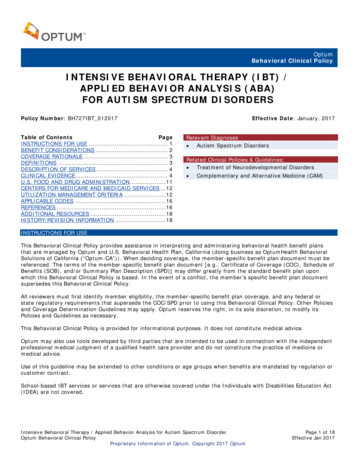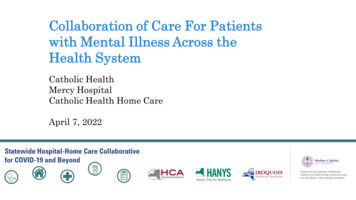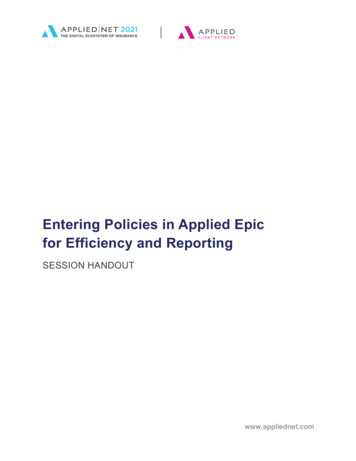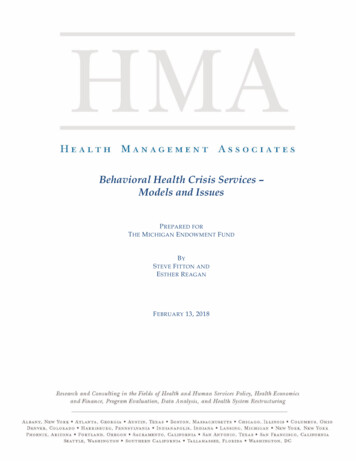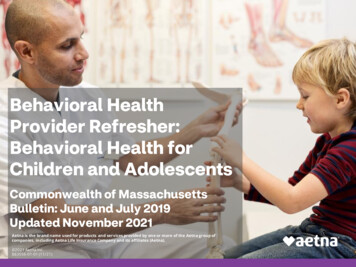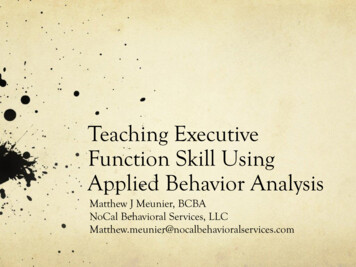
Transcription
Applied Behavioral Analysis andOther Behavioral Therapies for theTreatment of Autism SpectrumDisorderJune 2011Center for Evidence-based PolicyOregon Health & Science University3455 SW US Veterans Hospital RoadMailstop SN-4N, Portland, OR 97239-2941Phone: 503.494.2182Fax: olicycenter/med/index.cfm
AcknowledgementsThis report was prepared by:Alison Little, MD, MPHHeidi Kriz, MPH, RDAasta Thielke, MPHCenter for Evidence-based PolicyOregon Health and Science UniversityThis report was reviewed by:Valerie King, MD, MPHCenter for Evidence-based PolicyOregon Health and Science UniversityThis document was prepared by the Center for Evidence-based Policy at Oregon Health &Science University (the Center). This document is intended to support organizations and theirconstituent decision-making bodies to make informed decisions about the provision of healthcare services. The document is intended as a reference and is provided with the understandingthat the Center is not engaged in rendering any clinical, legal, business or other professionaladvice.The statements in this document do not represent official policy positions of the Center.Researchers and authors involved in preparing this document have no affiliations or financialinvolvement that conflict with material presented in this document.
This technology assessment report is based on research conducted by a contracted technologyassessment center, with updates as contracted by the Washington State Health Care Authority.This report is an independent assessment of the technology question(s) described based onaccepted methodological principles. The findings and conclusions contained herein are those ofthe investigators and authors who are responsible for the content. These findings andconclusions may not necessarily represent the views of the HCA/Agency and thus, no statementin this report shall be construed as an official position or policy of the HCA/Agency.The information in this assessment is intended to assist health care decision makers, clinicians,patients and policy makers in making sound evidence-based decisions that may improve thequality and cost-effectiveness of health care services. Information in this report is not asubstitute for sound clinical judgment. Those making decisions regarding the provision of healthcare services should consider this report in a manner similar to any other medical reference,integrating the information with all other pertinent information to make decisions within thecontext of individual patient circumstances and resource availability.
Table of ContentsExecutive Summary. 1Background . 7Figure 1. CDC Average Rates of Autism per 1000 Children . 12Figure 2. WA State Autism Population Estimate . 13Figure 3. Projected Costs for ABA Therapy Based on 50,000 Annual Benefit Cap . 13Figure 4. Related Medical Codes . 14Methods . 15Findings . 16Key Question 1. Among children ages 2 to 12 with ASDs, what are the effects of behavioral,treatment approaches that utilize ABA principles on core and commonly associated symptoms?. 17Key Question 2. Among children ages 2 to 12 with ASDs, what are the modifiers of outcome fordifferent behavioral treatments or approaches (including characteristics of the intervention,provider, child or family)? . 36Key Question 3. Are there any identifiable changes early in the treatment phase that predicttreatment outcomes?. 39Key Question 4. What is the evidence that effects measured at the end of the treatment phasepredict long-term functional outcomes? . 39Key Question 5. What is the evidence that specific intervention effects measured in the treatmentcontext generalize to other contexts (e.g., people, places, materials)? . 40Key Question 6. What evidence supports specific components of treatment as driving outcomes,either within a single treatment or across treatments? . 40Key Question 7. What evidence supports the use of a specific treatment approach in children underthe age of two who are at high risk of developing autism based upon behavioral, medical, or geneticrisk factors? .41Discussion. 43Guidelines . 54Policy Considerations . 59Summary . 61Appendix A. Summary of Guidelines . 64Appendix B. Quality of Guidelines . 76Appendix C. Summary of Medicare and Private Payor Policies . 77Appendix D. Summary of State Coverage Policies . 78Appendix E. Guideline Quality Assessment Tool . 81References . 83
Executive SummaryBackgroundAutism Spectrum Disorder (ASD) is a group of pervasive developmental disorders (PDD) thatincludes Autistic Disorder, Asperger Syndrome, and Pervasive Developmental Disorder, NotOtherwise Specified (PDD-NOS); it is estimated to affect 1 out of every 110 children. Autismspectrum disorder is characterized by impairments in communication, behavior, and socialinteraction and by repetitive behaviors coupled with obsessive interests, and is oftenaccompanied by comorbid conditions, such as epilepsy and mental retardation.A range of interventions are available for the treatment of ASD and the symptoms commonlyassociated with ASD (e.g., anxiety, sensory difficulties). Treatments for ASD focus on improvingcore deficits in social communication, as well as addressing challenging behaviors to improvefunctional engagement in developmentally appropriate activities. Common behavioralstrategies used in the treatment of ASD are based on learning theory and make use ofprocedures such as reinforcement, prompting, and shaping techniques to increase the rate ofpositive behaviors and reduce the frequency of unwanted behaviors. Positive reinforcementand other principles to build communication, play, social, academic, self-care, work, andcommunity living skills and to reduce problem behaviors in individuals with ASD have been usedby behavioral therapists.Applied behavioral analysis (ABA) is a general intervention approach for the treatment of ASD.It is a systemic application, at any time during a child’s day, of behavioral principles to modifybehavior. Some ABA techniques involve instruction that is directed by adults in a highlystructured fashion, while others make use of the learner’s natural interests and follow his orher initiations. Other techniques teach skills in the context of ongoing activities. All skills arebroken down into small steps or components, and learners are provided many repeatedopportunities to learn and practice skills in a variety of settings, with abundant positivereinforcement. Different applications of ABA include Positive Behavioral Interventions andSupport (PBS), Pivotal Response Training (PRT), Incidental Teaching, Milieu Therapy, VerbalBehavior, and Discrete Trial Training (also known as Discrete Trial Learning), among others.Early intensive behavioral intervention (EIBI) in contrast to ABA, is a much more prescriptive,manualized program that integrates components of ABA. Children in an EIBI program havetherapy approximately 40 hours per week over the course of up to two years. Proponents ofEIBI recommend starting therapy as early as possible and preferably before the age of three.Two manualized EIBI programs are the University of California, Los Angeles (UCLA)/Lovaasmodel and the Early Start Denver Model (ESDM). Both programs involve high intensityinstruction using ABA techniques but have several differences. The UCLA/Lovaas method usesone-on-one therapy sessions and discrete trial teaching. The ESDM uses ABA principles withdevelopmental and relationship-based approaches for young children. Other treatmentapproaches exist that emphasize parent training for treatment (e.g., Pivotal Response Training,Hanen More than Words) and/or use joint attention interventions, symbolic play, and playbased interventions (e.g., Stepping Stones Triple P Program, Relationship DevelopmentCenter for Evidence-based Policy1
Intervention (RDI), Mifne model). These therapies have not been manualized but are based onABA principles.Other behavioral interventions, aside from those based in ABA, are also used in the treatmentof ASD. Cognitive behavioral therapy is used to teach children with ASD to monitor and managetheir own behaviors through changing their perceptions, self-understanding and beliefs, basedon the assumption that change is most likely to occur when a child is actively involved in theirown behavior management. Neurofeedback involves the monitoring of brain activity while anindividual interacts with specially designed computer programs created to promote attention orother skills. Sleep interventions train parents and children strategies to deal with difficult sleepbehaviors common in children with ASD, and to establish sleep routines. All of these behavioralinterventions are used in addition to the ABA, ABA-based, and EIBI interventions describedabove.Currently, no Washington State agency covers ABA therapy for autism; however, other servicesthat are commonly identified as components or alternatives to ABA are covered given they areunder a treatment plan of medically necessary therapies. In comparison, an increasing numberof states are considering or have laws mandating insurers to cover the diagnosis and treatmentof ASD. Currently, 27 states mandate insurance coverage for treatment of autism, with anumber including the coverage of ABA in their mandates. Total lifetime per capita cost of directmedical treatment for an individual with ASD is estimated to be 305,956. Given the high costof treatment, the large number and variety of available treatments, and constrained budgets,state policymakers need to determine which treatments are likely to improve outcomes forchildren with ASD, so they can better target the use of limited state resources.MethodsAt the direction of the Washington HTA program, the recent Agency for Healthcare Researchand Quality (AHRQ) systematic review, Comparative Effectiveness of Therapies for Children withAutism Spectrum Disorders (Warren et al., 2011), was identified as the sole source of evidencefor this report.A search for relevant clinical practice guidelines was conducted using predetermined highquality sources from the Medicaid Evidence-based Decisions Project (MED). Included guidelineswere limited to those published after 2005. Select private and federal payor coverage policies,as identified by the Washington HTA program, were reviewed. State coverage policies wereidentified through the National Conference of State Legislatures, Kaiser Family Foundation, andAutism Votes.Included clinical practice guidelines and the Warren et al. (2011) systematic review were qualityassessed using standard instruments developed and adapted by the MED Project that aremodifications of systems in use by the National Institute of Clinical Excellence (NICE) and theScottish Intercollegiate Guidelines Network (SIGN), and the Appraisal of Guidelines Researchand Evaluation (AGREE) Collaboration, respectively.Center for Evidence-based Policy2
FindingsThe Warren et al. (2011) systematic review evaluated a wide variety of interventions, includingbehavioral, educational, family, medical, allied health and CAM treatment approaches.However, at the direction of the Washington HTA program, this report is limited to behavioralinterventions that are not delivered in an educational setting.Methods (Warren et al., 2011)Methods of the Warren et al. (2011) systematic review included studies published in Englishfrom January 2000 to May 2010. The MEDLINE , ERIC and PsycInfo databases were searched,as well as grey literature from the US Food and Drug Administration, and clinical trial registriessuch as ClinicalTrials.gov. Reference lists were hand searched. All study designs were includedexcept case reports. Medical studies with fewer than 30 participants, and behavioral,education, and allied health studies with fewer with 10 participants were excluded. Studieswithout a comparison group with at least 10 children with ASDs were included in the review.Single-subject design studies were not excluded on the basis of their design alone. However,the majority of single subject studies do not include at least 10 participants and were thereforenot included in the Warren et al. (2011) review.Two reviewers quality assessed each study with differences resolved through discussion.Studies were rated as good, fair, poor. The overall strength of the evidence was assessed usingthe Evidence-based Practice Centers Methods Guide for Effectiveness and ComparativeEffectiveness Reviews. The strength of evidence was presented as insufficient, low, moderate,or high.Results (Warren et al. 2011)Searches retrieved 4,120 citations, of which 183 articles representing 159 studies were includedin the report. Of these, 78 studies pertained to behavioral interventions.Key Questions [modified for Washington HTA to focus on behavioral interventions only]KQ1. Among children ages 2 to 12 with ASDs, what are the effects of behavioral, treatmentapproaches that utilize ABA principles on core and commonly associated symptoms?The evidence suggests that early intensive behavioral and developmental intervention (EIBDI)may improve core areas of deficit for individuals with ASDs; however, randomized controlledtrials (RCTs) are few and include small numbers of participants. In addition, there are no directcomparison trials. Within this category, studies of UCLA/Lovaas-based interventions reportgreater improvements in cognitive performance, language skills, and adaptive behavior skillsthan other broadly defined treatments. However, strength of evidence is currently low. Inaddition, the consistency of benefit is lacking, in that not all children demonstrate rapid gains,and many children continue to display substantial impairment. Although positive results arereported for the effects of intensive interventions that use a developmental framework, such asESDM, evidence for this type of intervention is currently insufficient because few studies havebeen published to date.Less intensive interventions focusing on providing parent training for bolstering socialcommunication skills and managing challenging behaviors have also been studied. SomeCenter for Evidence-based Policy3
interventions have shown short-term gains in social communication and language use, but thecurrent evidence base for such treatment remains insufficient.Although all of the studies of social skills interventions reported some positive results, mosthave not included objective observations of the generalizability and the maintenance of theimprovements. Strength of evidence is considered insufficient for social skills training and playand interaction-based approaches. Several studies suggest that interventions based oncognitive behavioral therapy are effective in reducing anxiety symptoms, but replication ofresults is needed. Strength of evidence for these interventions is currently insufficient.KQ2. Among children ages 2 to 12 with ASDs, what are the modifiers of outcome for differentbehavioral treatments or approaches (including characteristics of the intervention, provider,child or family)?Only two studies were identified that directly addressed this question. One analyzed the initialcharacteristics of the subject children and found that children who were low in initial objectexploration benefited more from Response Education and Prelinguistic Milieu Teaching (RPMT),while children who were relatively high in initial object exploration demonstrated more benefitfrom Picture Exchange Communication System (PECS). Another study examined the impact ofwhich provider (parent vs. professional) delivered the UCLA/Lovaas protocol-basedinterventions. There was no significant difference in outcomes for children receiving theintervention in a clinical setting vs. at home from highly trained parents.Other potential correlates that warrant further study because of conflicting data includepretreatment IQ and language skills, and age of initiation of treatment (with earlier agepotentially associated with better outcomes). Social responsiveness and imitation skills havebeen suggested as skills that may correlate with improved treatment response in UCLA/Lovaastreatment, whereas “aloof” subtypes of ASDs may be associated with less robust changes in IQ.Other studies have seen specific improvement in children with PDD-NOS vs. Autistic Disorderdiagnoses, which may be indicative of baseline symptom differences. However, many otherstudies have failed to find a relationship between autism symptoms and treatment response.KQ3. Are there any identifiable changes early in the treatment phase that predict treatmentoutcomes?The literature offers very little information about characteristics or responses early in treatmentthat might predict long-term outcomes. Some evidence suggests that changes in IQ over thefirst year of either UCLA/Lovaas-based or ESDM intervention predicts, or accounts for, longerterm change in IQ.KQ4. What is the evidence that effects measured at the end of the treatment phase predictlong-term functional outcomes?One study specifically addressed end-of-treatment effects to predict longer range outcomes.The feasibility of such studies was established in this language study, which reported outcomes12 months post intervention.Center for Evidence-based Policy4
KQ5. What is the evidence that specific intervention effects measured in the treatment contextgeneralize to other contexts (e.g., people, places, materials)?Few studies measured generalization of effects seen in treatment conditions to either differentconditions or different locations. Among behavioral studies, those of treatments for commonlyassociated conditions, such as anxiety, employed outcomes assessment outside the therapeuticenvironment, with positive results observed. However, in most cases, outcomes are parentreported and not confirmed by direct observation.KQ6. What evidence supports specific components of treatment as driving outcomes, eitherwithin a single treatment or across treatments?No studies were identified to answer this question.KQ7. What evidence supports the use of a specific treatment approach in children under theage of two who are at high risk of developing autism based upon behavioral, medical, or geneticrisk factors?Research on very young children is preliminary, with four studies identified. One good-qualityRCT suggested benefit from the use of ESDM in young children, with improvements in adaptivebehavior, language, and cognitive outcomes. Diagnostic shifts within the autism spectrum werereported in close to 30 percent of children but were not associated with clinically significantimprovements in ADOS severity scores or other measures.GuidelinesTwo guidelines (NZ 2010; SIGN 2007) make recommendations for ABA and interventions basedon ABA principles. The SIGN (2007) guideline states that the Lovaas program should not bepresented as an intervention that will lead to normal functioning, and that behavioralinterventions should be considered in young people with ASD. The New Zealand (NZ) (2010)guideline states that ABA should be considered for children and young people with ASD, andthat there is a lack of knowledge about the suitability of ABA for persons with AspergerSyndrome and those 15 years or older. The NZ guideline also recommends the use of EIBI inyoung children with ASD but states that regular monitoring for the evaluation of effectiveness iscrucial. The NAC (2009) and AAP (2007) guidelines summarize the evidence and do not makespecific recommendations.Three guidelines (NAC, NZGG, and SIGN) included in this report addressed CBT. All threeguidelines state that CBT can be a therapy option. The SIGN guideline (based on a systematicreview of the evidence) was unable to draw conclusions about the effectiveness of CBT andrecommends that professionals be aware that some of these interventions require a level ofverbal and cognitive development. Other interventions addressed in this report were notcovered by the included guidelines, were not supported by the evidence, or were grouped intobroad categories making it difficult to draw conclusions about the individual interventions.Center for Evidence-based Policy5
Policy ConsiderationsFederal, state and private payor policies are not consistent in mandating coverage of ABAtherapy for the treatment of ASD. Of the federal and private payor policies reviewed, Aetna isthe only payor to cover intensive educational interventions and explicitly mentions that there isinsufficient evidence regarding the superiority of any specific intervention, such as ABA. Anincreasing number of states have coverage mandates for the diagnosis and treatment of ASD.Mandate components, such as included treatments, age restrictions, and maximum benefitlimits vary significantly between states. With a lack of standardized educational and/orpractical requirements for ABA providers, a small number of states have included ABA LicensureBoards in their state coverage mandates.Limitations of the evidence There are very few well-controlled trials for ASD treatments based in ABA theory. Most studies report on short-term outcomes and the degree to which those outcomestranslate to functional outcomes over time is largely unknown. The range of treatment approaches evaluated in the literature may not match thosethat are available in practice, and the highly controlled treatment environments may nottranslate to outcomes that can be achieved in the community. Fidelity to treatment in the community may be limited, particularly for thoseinterventions that are not manualized. Of the published trials, many have small sample sizes, different treatment approaches,varying durations of treatment, different follow-up times and outcome measures, andcover a variety of treatment intensities.Center for Evidence-based Policy6
BackgroundClinical overviewAutism Spectrum Disorder (ASD) is a group of pervasive developmental disorders (PDD) thatincludes Autistic Disorder, Asperger Syndrome, and Pervasive Developmental Disorder, NotOtherwise Specified (PDD-NOS) (Warren et al., 2011). The Centers for Disease Control andPrevention (CDC) estimate the national prevalence of ASD to be 9.0 per 1,000 children agedeight years, or 1 out of every 110 children (Rice, 2009). The prevalence in males is 4.5 timesgreater than the prevalence in females (CDC, 2010; Rice, 2009). Autism spectrum disorder ischaracterized by impairments in communication, behavior, and social interaction and byrepetitive behaviors coupled with obsessive interests, and is often accompanied by comorbidconditions (Warren et al., 2011). About a third of individuals with ASD have epilepsy and threequarters have mental retardation (CDC, 2002; Myers & Johnson, 2007).A range of interventions are available for the treatment of ASD and the symptoms commonlyassociated with ASD (e.g., anxiety, sensory difficulties). Treatments for ASD focus on improvingcore deficits in social communication, as well as addressing challenging behaviors to improvefunctional engagement in developmentally appropriate activities (Warren et al., 2011). Autismspectrum disorder lacks a cure and there is no universal consensus on which treatmentinterventions are most effective (Warren et al., 2011).General description of treatments based on behavioral principlesBehavioral strategies are based on learning theory 1 and make use of procedures such asreinforcement, prompting, and shaping techniques to increase the rate of positive behaviorsand reduce the frequency of unwanted behaviors. Since the early 1960's, hundreds of behavioranalysts have used positive reinforcement and other principles to build communication, play,social, academic, self-care, work, and community living skills and to reduce problem behaviorsin learners with autism of all ages. Behavioral therapies have often been adapted for trainingparents and teachers to be a part of, and sometimes the primary providers of, the therapy.The effectiveness of behavioral interventions to improve the functioning of children with ASDand to ameliorate behavioral difficulties has been recognized since the 1960’s (Bandura, 1969;Ullman & Krasner, 1965). Over the past four decades there has been a steady growth inbehaviorally based programs for young children with ASDs under a number of different titles.Although many psycho-educational and behavioral interventions aim to help with specific skillsor symptoms, more comprehensive intervention programs for young children with ASD aim toaddress elements of behavioral, developmental and educational functioning. Thesecomprehensive intervention approaches are described in more detail below, followed by asummary of those interventions that aim to address specific skills.1All psycho-educational programs have important elements in common and essential components of many aretechniques developed from learning theory (Skinner, 1953). Behavioral strategies, sometimes referred to asbehavior modification or operant conditioning, involve the use of consequences to modify the occurrence andform of behavior. These principles are part of any successful education program for any child, not just childrenwith ASD.Center for Evidence-based Policy7
Behavioral InterventionsApplied Behavioral Analysis (ABA) – Applied Behavior Analysis (ABA) means the systematicapplication of behavioral principles to modify behavior at any time during the child’s day. Itwas first defined as “the process of applying sometimes tentative principles of behavior to theimprovement of specific behaviors and simultaneously evaluating whether or not any changesnoted are indeed attributable to the process of application” (Baer, Wolf, & Risley, 1968, p. 91).Some ABA techniques involve instruction that is directed by adults in a highly structuredfashion, while others make use of the learner’s natural interests and follow his or herinitiations. Other techniques teach skills in the context of ongoing activities. All skills are brokendown into small steps or components, and learners are provided many repeated opportunitiesto learn and practice skills in a variety of settings, with abundant positive reinforcement. Thegoals of intervention, as well as the specific types of instructions and reinforcers used, arecustomized to the strengths and needs of the individual learner. Performance is measuredcontinuously by direct observation, and the intervention is modified if the data show that thelearner is not making satisfactory progress.Applied behavior analysis is a general approach to intervention which is readily adaptable tomany different circumstances and settings and can therefore be used in treatment of ASD,either as a technique for teaching specific skills, or to form the basis of a comprehensivetreatment program in combination with a range of other psycho-educational and behavioralstrategies. In comprehensive ABA, the skills and behavior of each child are assessed, andappropriate functional skills to be taught are chosen with respect to the child’s ability. Theteaching environment is continually analyzed to optimize classroom structure, adaptinstructional activities, and to develop meaningful curricula. Different applications of ABAcommonly used for individuals with ASD include Positive Behavioral Interventions and Support(PBS), Pivotal Response Training (PRT), Incidental Teaching, Milieu Therapy, Verbal Behavior,and Discrete Trial Training (also known
Support (PBS), Pivotal Response Training (PRT), Incidental Teaching, Milieu Therapy, Verbal Behavior, and Discrete Trial Training (also known as Discrete Trial Learning), among others. Early intensive behavioral intervention (EIBI) in contrast to ABA, is a much more prescriptive, manualized program that integrates components of ABA.
